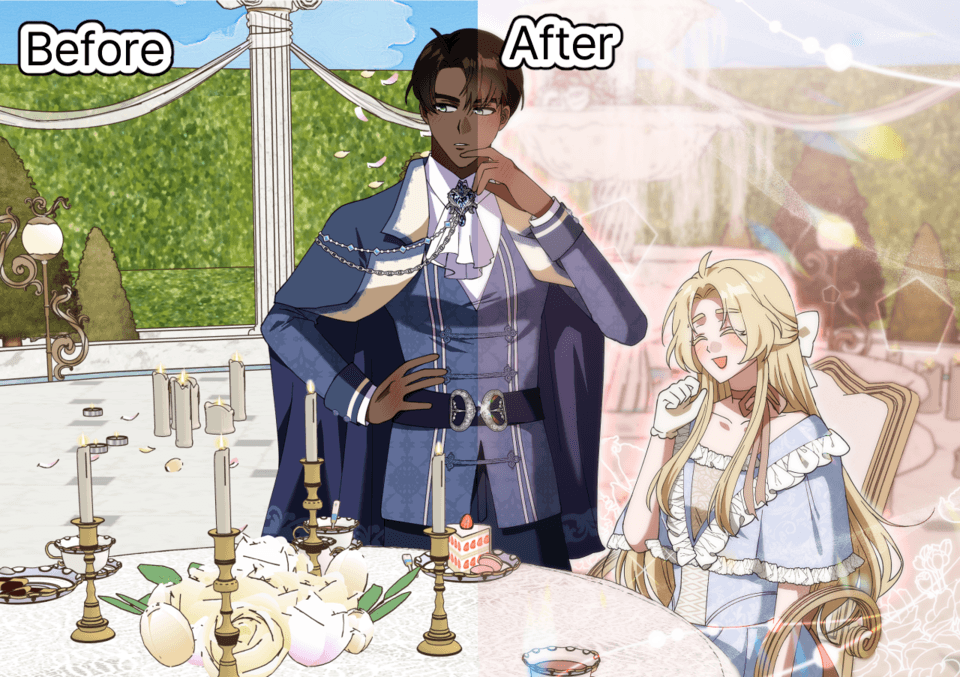How I learned to draw hands
Hi, I'm Megumi, and this tutorial is all about drawing hands. For many artists, hands are a red cloth. I remember myself that my characters had them behind my back or in my pockets, but hands are actually a very important part of the expression! That is why it is absolutely worthwhile to face the challenge and to practice drawing hands. Yes, practice - that is the key word here. Unfortunately, this is not a guide on how to become a master quick 'n dirty, but I will tell you a little about my own way of learning how to draw hands.
anatomy
The hand consists of the palm, fingers and thumb. I count the thumb extra because it is the “opponent” of the fingers, so to speak. Incidentally, this is something that distinguishes the human hand, the mobility of the thumb makes many fine motor actions possible!
I like to draw the palm like a trapezoidal sponge. The fingers, when they lie together, roughly form its mirror image. The upper end is roughly divided into 4 parts, where the fingers come. The middle finger is about as long as the palm of your hand. If you look at the hand from above, you will see that the middle finger base joint is not where the fingers start, but a little further on the back of the hand. The first finger joint lies in the middle between the middle finger base joint and the fingertip, the rest is shared by the other two finger joints. Half of the top phalanx is the nail bed, and if you let the nail protrude a bit beyond your fingertip, it looks a little more elegant. Ring and index fingers next to it extend up to half of the uppermost phalanx of the middle finger. The little finger is narrower than the others and ends approximately at the level of the second phalanx of the ring finger.
The thumb, unlike the rest, sits at the bottom of the palm. Take a look where the fixed joint sits - the entire ball of the thumb is very flexible and the crumple zone does a lot of the naturalness of the hand movement afterwards.
Something that I didn't realize until much later was that the palm of the hand isn't as firm as it seems. The fact that the upper third consists of the basic finger joints and the metacarpal bones are flexibly connected to each other, the palm always bends a little when moving. Using this fine movement well also makes it important if you want to add a little more dynamism to your gestures.
Can we draw hands now?
What I have said here is anything but new - most drawing tutorials on hands explain the anatomy to you in exactly the same way or better. But no matter how often you read this: You learn to draw by drawing! So hold a pen and practice, practice, practice. Even if it looks like cabbage and beets at first, over time you will find your own way to deal with the matter.
Step 1 - references!
If you think you know what hands look like, you probably still don't really know. How many S! You can find more on this topic on our blog under Learn to draw with Megu - what I am just saying is: Find references! Anyone who says you don't need one has no idea! All professionals work with templates, even many templates at the time, take pictures of their own hands for difficult poses etc. etc. Here I have collected a few hand references on Pinterest, where you can find something to practice with. (https://www.pinterest.de/megusagi_art/hands/) Incidentally, references can be wonderfully placed in the subview window, then they remain in view. You can find Subview under Window> Subview. I like to put it in the top right corner, it doesn't bother me and I can keep an eye on it from time to time.
For copyright reasons, here in the tutorial I replaced the photo reference I used with a picture I had painted myself. Please don't let this irritate you and use photo references!
3D models or drawings for reference
If you have a little experience with hand drawing, and especially if it is for comic scenes, etc. If you want to go faster, the 3D models available at CSP are well suited to simulate and trace hand poses as well. However, I would like to have said that it is a) difficult to create dynamic hand poses without experience, and b) the finger joints are good, but the palm is quite stiff. With a bit of experience, this shortcoming can be easily compensated, but for learning I strongly recommend sticking to photo references.
I also find it critical to use drawings as references - if you don't have the experience to judge whether the hand movement is natural or not, you take on the mistakes that the original artist makes.
Step 1 - sketch
I often work with several sketch layers from coarse to fine, which I use to separate colors by layer properties> layer color. I like to use the standard brush "Light Pencil" to sketch, because the line is nice and soft and fast. I usually proceed by first outlining the palm and approximate shape. If a pose is very complicated, I also like to draw guidelines on the template, because it is much easier to understand a simple form than to “think it through” and record it on the fly. It also helps to get away from the superficial information - like everywhere in figurative drawing, it is important to keep in mind what you cannot see!
Step 3 A - Ink
If I want to make a sketch with outlines from the sketch, I try to overdo the gesture a bit, and also to overdo the features. Slightly longer fingers look more elegant, I separate the straight limbs from the ankles by making the phalanges a bit curvy, and I make sure that I make the overlapping areas as precisely as possible. In pure black and white drawing, I try to think of the outlines not only as a silhouette, but as the areas with the deepest shadows. This makes it easier for me to find out where I am making the lines thicker and where I am making them thinner, in order to still create depth without shading.
Step 3 B - shaded monochrome
When the pure outlining got a bit too boring, I started to shade my hands. For this I colored the background in a light gray or beige and chose a textured pencil; the standard rough pencil works well for this. I keep the pen in the same color range as the paper, but I choose a darker shade for the outlines and a lighter shade for highlights. Hatching out the depths and working out the heights not only make the hands more plastic - it also just makes me think better about which shape and which level moves in which direction. Continuing to practice in this style has brought me a lot for the simpler-looking ink drawings.
Step 3 C - in color!
At the beginning, I simply made the colored versions on the gray paper, and that's probably not entirely wrong. However, I soon found that the surrounding color is much more important than I thought! So if you want to take a bit of color with you as well as practicing your hands, I recommend the following:
Create two new layers under the sketch layer - you fill one with the fill tool with an average of the background color of the original. If you want, you can also make rough gradients or the like.
On the level above you paint with a brush of your choice - I use a watercolor brush for this - the outlines with an average of the skin color. From here you can proceed differently. You can either pick the color from the template to e.g. to work out the shadow areas. It is quite interesting to observe in which spectrum the color wheel is moving, because where it looks like "bluish" it is often only less saturated in the direction of yellow or magenta. Colors always look very different, depending on which colors surround them, and have a strong influence on each other. Hence the background color first: The skin color looks much darker and muddy on a white background than on a dark one! If you had only removed the skin color from the original, you would soon have wondered why your drawing looks so different from the original.
Watch closely what the colors do on the skin - it communicates as much as the movement it is in. If the fingertips are a lot red and the rest of the hand is pale, it will look like cold hands, for example. When light falls between the fingers, a lot of red can often be seen in the edge area of the highlights, which is due to the fact that the light falls through the translucent skin onto the fine blood vessels before it is reflected to the eyes. Observing and trying to understand why things behave in this way is, in my opinion, the way to really learn to draw.
100 Hands-Challenge
The Challenge was something I did for myself in early 2020 to eliminate my hand drawing problems. I really wanted to be able to draw beautiful, expressive hands - but what developed from it was much more. I started to have a better feeling for colors and also for spatial thinking. It took a bit of perseverance and I admit to the last 5 pairs of hands I almost ran out of breath. My community, who also participated in the campaign, helped me a lot, so we motivated each other when the going got tough. In retrospect, I am very proud to have pulled it off and can only recommend anyone who is concerned with figurative drawing to face a challenge like this every now and then! In the sense of many thanks for the attention <3 Megumi
























Comment